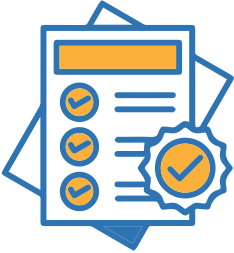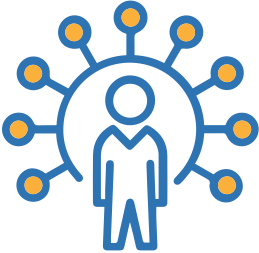Using Chatbots To Improve Lead Generation
Creating a good website experience is essential to the chances of generating leads from the traffic you attract to your site. A poor website experience is one of the main obstacles that get in the way of your ability to generate leads. Visitors who are unable to find what they’re looking for, who aren’t sure what they’re looking for, or who simply have basic questions about your products or services may grow frustrated navigating your site. One of the most effective ways to address these potential issues, while simultaneously improving the website experience, is by implementing a website chatbot.
A chatbot provides visitors with a resource that they can turn to at any time during their session for guidance, whether they’re looking for something in particular or have basic questions that are preventing them from learning about a solution to their problem. Standard live-chat applications require customer support representatives to remain available to respond to visitor queries compared to a chatbot that is preprogrammed to address common queries providing either the desired resource or the opportunity to connect with a representative.
What Is A Chatbot?
Chatbots are software programs that are designed to converse with website visitors in a way that mimics an actual, human conversation. They can be programmed to identify basic requests and to provide information and answers based on the context of their interactions with users. They can be incredibly beneficial for engaging visitors on your website and helping provide basic information and guidance. There are two main types of chatbots that you can implement:
Simple Chatbots
A simple chatbot functions based on pre-prepared commands. These commands are written by the developer using regular expressions and basic keywords. This means that if a user asks a question that doesn’t contain any of the keywords used by the developer to program the chatbot, the chatbot won’t be able to understand what the user is asking. When this happens, a pre-written message is usually presented to the user explaining that the question wasn’t understood, such as “I’m sorry, I didn’t understand your question. Let me help you connect with a representative.”
Smart Chatbots
While simple chatbots function using pre-prepared answers, smart chatbots are programmed using artificial intelligence. A smart chatbot is capable of remembering the context of conversations and user preferences to provide more personalized and relevant responses to the user. Smart chatbots are able to do this as a result of being programmed to understand specific keywords and phrases. Using machine learning, they can then use their programming as a foundation to better understand user queries and responses through past interactions.
How Chatbots Differ From A Live Chat Application
Most people who visit a website prefer to interact with a live chat feature because they will be engaging with an actual person in real-time. If the visitor has a more complicated question or needs more in-depth guidance, an actual customer support representative will be more helpful, especially when compared to a simple chatbot. However, a lot of resources are required in order to provide live support. Although a customer support rep can handle three or four user queries at any given time, you might have trouble if there’s a spike in traffic and a large number of queries come in, especially if they are at odd hours of the day, which is why chatbots can be so useful.
The Benefits Of Using A Chatbot
Implementing a chatbot can be extremely beneficial in many different ways. In fact, a chatbot can be a useful addition even if you already have a live chat feature installed on your website. Not only can a chatbot help to greatly improve your website experience on its own, but it can also complement your existing customer support team, allowing them to work even more effectively and efficiently. Here are some specific benefits of using a chatbot:
Reduce Overhead By Replacing Live Support
Although having customer support representatives available for live support is ideal, it can be quite costly. A single customer support rep can only handle three to four interactions at any given time. Once your business begins growing, even a small group of customer support reps won’t be able to handle the needs of all of your visitors over the course of an entire day. The real issue with this is that it simply costs too much for most businesses to hire that many reps to address the needs of their visitors. Implementing a chatbot to complement your existing customer support staff is simply much more cost-effective.
Improve Customer Support
Most websites that have live chat can only offer support during regular business hours as 24/7 support requires a lot of resources and expenditures. Chatbots help to improve your customer support capabilities by being available to help visitors 24/7.
Additionally, human customer support reps can make errors, especially if they’re handling too many interactions at once. A chatbot will eliminate errors, thereby improving the reputation of your customer service. Not to mention that if customer support reps are being overwhelmed with visitor inquiries, there may be times where they won’t be able to respond to a visitor’s question, which can result in the loss of a potential lead. Chatbots have a 100 percent response rate, so you’ll never have to worry about a visitor’s query not being addressed.
Save Time
Without a chatbot, your existing customer support team is likely spending a lot of time responding to the same questions and concerns over and over again, whether it’s through a live chat feature or through other channels, such as email or phone. The time that they’re spending answering basic questions could be put to much better use, such as addressing more complicated issues that other customers might be having. A chatbot can be programmed to address the most common questions and concerns so that your customer support team doesn’t have to.
Improve Engagement
One of the keys to capturing leads is to keep your visitors engaged. The longer they spend on your website, the more likely they are to convert. Chatbots help to improve engagement. You can program them to engage as soon as someone arrives on your website, letting them know that they have support if they need it. Visitors are less likely to grow frustrated if they can turn to a chatbot for help.
You can also program your chatbot to have a personality so that its replies don’t read like scripted responses. The interaction a visitor has with a chatbot reflects on the reputation of your brand, so if the chatbot is helpful, friendly, and slightly humorous, it can help make your brand feel more relatable on a personal level. Finally, chatbots can collect information from your visitors (such as by asking the visitor what they’re looking for or by simply monitoring their behavior on your site). This allows the chatbot to personalize the experience of your individual visitors more successfully.
Collect Valuable Customer Data
Chatbots can be used to collect valuable customer data. They are almost like interactive forms. For example, your chatbot can ask visitors a few basic questions to help make their experience better. These questions can be simple, such as “What is your name and email address?” or “What industry do you work in?” or “What kind of solution are you looking for?” In addition to tracking their behavior, this data can be extremely useful in helping to address a prospect’s needs and personalizing their experience.
Qualify Your Leads
Not all of your visitors will become leads — and those that do convert may not always be high-quality leads. Qualifying your leads means that your marketing and sales teams don’t waste a lot of time and effort attempting to nurture someone with little interest in eventually making a purchase. Fortunately, chatbots are quite useful at helping to qualify your leads.
By programming your chatbots to ask certain questions, you can qualify your visitors. For example, the first question could be whether the visitor is a business owner. You can follow that up with a prompt to provide your chatbot with more information about their business or to inquire why they are visiting your website. Based on the answers to these questions, a chatbot can follow up by asking if the visitor knows about a relevant service or product you sell.
This kind of information is a great way to judge whether a visitor could be a high-quality lead or not without sounding too pushy. If the intent to purchase is obvious from the visitor’s answers, then you can even have the visitor’s chat rerouted to a live sales representative.
Help Boost Sales
Chatbots can help close sales in a number of ways. Customers who are in the decision stage may have questions about products or services that a chatbot can answer to help influence their decision.
Chatbots can also present visitors with information about promotions, new products or services, or recommendations, all based on how the visitor has been engaging on your website. For example, if a visitor spent some time looking at products or services, left your website, then returned later, offering them a special promotion (such as a free trial or free shipping) could help convince them to make the purchase. In some cases, visitors may not even know about certain products or services, but a chatbot can make recommendations based on content the visitor was viewing or downloading.
Optimizing Your Chatbots To Improve Their Impact
Chatbots offer a variety of benefits when properly implemented. They do, however, have to be programmed, even if you’re implementing a smart chatbot. The process of optimizing your chatbots will ensure that they help you achieve the best results. Here are the steps that you will need to take to properly optimize your chatbot:
Establish Goals
Because chatbots can be used to your advantage in so many different ways, you need to figure out exactly why you need a chatbot in the first place. For example, maybe your conversion rate has been dropping in recent months and you want to find a way to engage and help visitors more effectively. Or maybe you’re having issues qualifying your leads and need help strengthening that process. It’s important that you establish your goals so that you know how to program your chatbot.
Choose The Platform
Once you know what your goal is, the next step is to choose a platform. Your website isn’t the only platform on which you can implement a chatbot. Chatbots can be used on a number of different social channels as well. For example, Facebook Messenger and Twitter Direct Message are both chatbot programs that you can take advantage of. A company that is having trouble responding to all of the messages they’re receiving on Facebook might use Facebook Messenger to help reduce their support team’s workload.
Create Several Welcome Messages
When creating a welcome message, focus on a message that is compelling (shows off the chatbot’s personality), that sets expectations for any future interactions, and that asks a question to initiate engagement. Be sure to program multiple welcome messages so you can present more relevant welcome messages based on the visitor. For example, if the visitor has arrived on your homepage, the welcome message can ask “How can I help you?” whereas if they arrive on your products and services page, a more relevant question might be “Can I help you find anything specific?” You may even want to have a slightly different message for returning visitors, such as “Welcome back!”.
Use A FAQ To Program Answers To Common Questions
Chatbots are a useful way to provide customers with information and answers to basic questions, saving time on your end. In order to pre-program your chatbot to be able to answer basic questions, use an FAQ to guide you. Even if you have an FAQ page on your website, you should still incorporate these questions and answers into your chatbot’s programming. This is because many visitors won’t always make it to your FAQ page if they have a question and interacting with a chatbot is more convenient and engaging.
Use Information From Sales, Marketing, And Support Teams
Work closely with your sales, marketing, and customer support teams to identify some of the most common questions and concerns that they have to address. Use this information when programming the questions and answers of your chatbot. You can also identify when visitors should be re-routed to the actual marketing, sales, or customer support representatives based on the qualifying information that these departments provide to you.
Program The Chatbot To Ask Questions As Well As Give Answers
While you do want the chatbot to be able to answer common questions and provide general advice when needed, you should also program the chatbot to respond with questions when it’s appropriate. Questions can help drive the conversation forward and keep the visitor engaged as well as allow you to collect more useful information about that visitor.
Build Out Conversation Trees
Not every response your chatbot provides is going to be replied to in the same way, so you will need to build out your conversation trees when programming the chatbot. For instance, a chatbot on the website of a restaurant might initiate the conversation with a simple welcome message asking how they can help. If the response is “order food” then the chatbot should be able to walk the visitor through the process of ordering food online by responding with questions such as “What would you like to order?” and “How would you like to pay?” However, if the visitor wants to reserve a table at the restaurant, different responses will be required, such as “What time would you like to make your reservation for?” and “For how many people?”
Apply An Appropriate Personality
A chatbot is supposed to mimic a human conversation, which means that you’ll want to give it a personality. If you don’t, its messages will sound very scripted and dry, which isn’t very engaging. By adding some personality to its messages, you align the chatbot more closely with your brand and help humanize the user experience. You can even give your chatbot a name. Although visitors will never forget that they’re speaking with a chatbot (don’t try to fool them into thinking they’re speaking with a live representative), they will appreciate the effort to engage with them on a more personal and relatable level.
Supplement Text With Video And GIFs
Keep in mind that the messages your chatbot delivers are a form of content. As such, supplementing the text that visitors have to read with visuals can make the experience more engaging for them. The addition of videos, images, and GIFs when appropriate can make the interaction more fun and memorable. For example, if the visitor indicates that the chatbot has resolved their question, you could program it to respond with a message such as “Glad I could help!” followed by a thumbs-up emoji.
Keep Information Updated
You may be using newer information to provide certain messaging. This means that you will need to update your chatbot’s messaging routinely to make sure none of the information it provides is out of date. For example, if your chatbot has been programmed to provide information about current promotions, then you need to update it as soon as the promotion ends. Visitors will be very annoyed if a chatbot advertises a promotional event that ended months ago.
Use Chatbots To Generate More Leads And Sales
Chatbots are a great way to improve your user experience, whether on your website or on your social channels. With the use of chatbots, you can help keep visitors engaged and help to identify and/or address their needs immediately. Not only can this help you to generate more leads and sales, but it can also do so in a very cost-effective manner that can help to save a significant amount of time for your sales and customer support departments, and allow them to focus their time and effort on more pressing matters.















